
Early Japanese guitar manufacture is often shrouded in the unknown. Numerous manufacturers often built very similar guitars, with some items of hardware common to guitars from different makers. However, although little is published about the manufacture or specifications of this pickup, it does appear to have solely appeared on guitars produced by Matsumoku. Its construction has many similarities with pickups made by Maxon (compare with the Maxon humbucker) fitted to Matsumoku-built Les Paul style guitars, and seems most likely to have been made by them. It actually it has a very distinctive look, with its trapezoid black/white covers, and along with the metal-capped knobs and "Steel Adjustable Neck" / "Steel Reinforced Neck" neckplate, is a clear indicator of a late 1960s/early 1970s Matsumoku-built guitar.
Like other Matsumoku parts, this pickup is reasonably complicated in construction, and consists of numerous parts.
This pickup is best known today for its use on the early Japanese Epiphone solid body, the ET-270, although by the time this had launched it had been fitted to numerous other models from 1966 onwards. Guitars known to be fitted with this pickup include:
| Aria model | Description | Rebadged as |
|---|---|---|
| Aria 1202T / 1303T (two / three pickups) | Hollow body electric acoustic | Angelica 2856, Conrad 40080 / 40085 (double/triple pickup), Conqueror, Commodore N177, Domino 40E2 "Dawson", Greco 950, Lyle, Orlando, Pan P-D / Pan P-T (double/triple pickup), Raven, Toledo, Univox HR-2, Ventura V-1000 |
| Aria 1212 | Hollow body electric acoustic twelve string | Angelica, Conrad 40100, Greco, Pan P-12, Toledo |
| Aria 1402T | Hollow body violin guitar | |
| Aria 1532T | Offset solid body | Commodore 179 |
| Aria 1802T / 1832T / 1803T (three pickups) | Strat-shaped solid body | Conrad, Eros 9525, Epiphone ET-270, Luxor 1803T, Lyle 1802T, Tempo, Toledo 18021 |
| Aria XXX | Strat-shaped hollow body | Stewart, Toledo |
A closer look will reveal some of these 'rebadged' guitars have other changes than the branding: different cutaways (for example Angelica and Greco hollow bodies have Florentine rather than Venetian cutaways), different hardware (usually the tailpiece / vibrato), or, as is the case with the Epiphone ET-270 a completely different neck design.
List of Matsumoku pickups
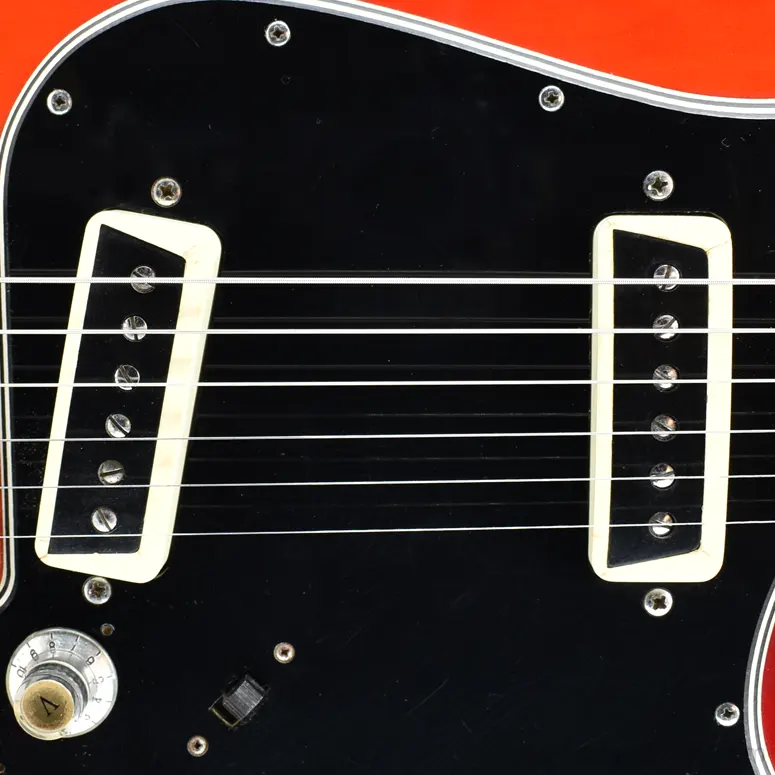
A pair of Matsumoku trapezoid pickups fitted to a 1971 Epiphone 1802T (ET-270). This was the only Epiphone model to be fitted with these pickups.
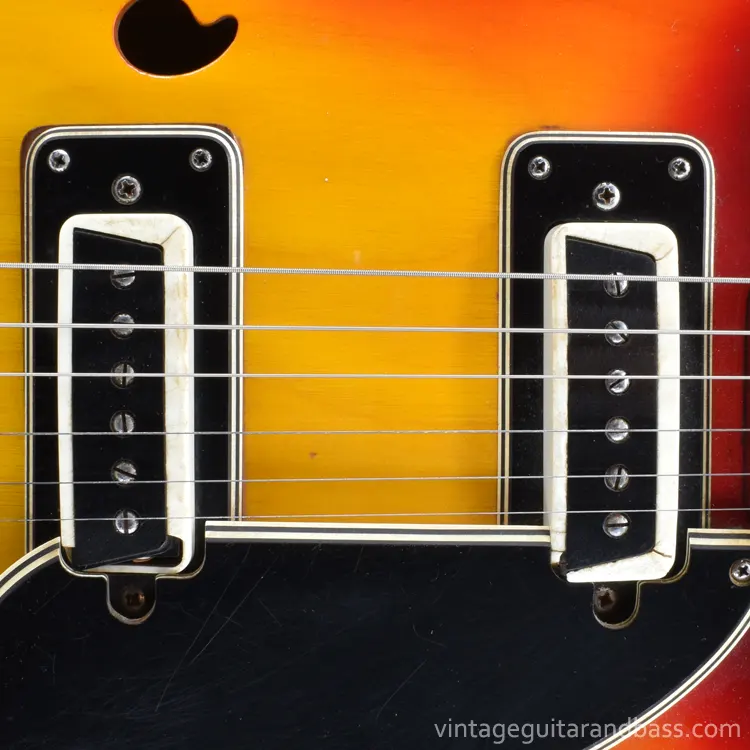
Matsumoku trapezoid pickups fitted to a Commodore N177. The biggest issue with these pickups is the fragility of the plastic surrounds. Damage does not always affect functionality, which is somewhat fortunate as examples without damage, or at least small cracks are rare.
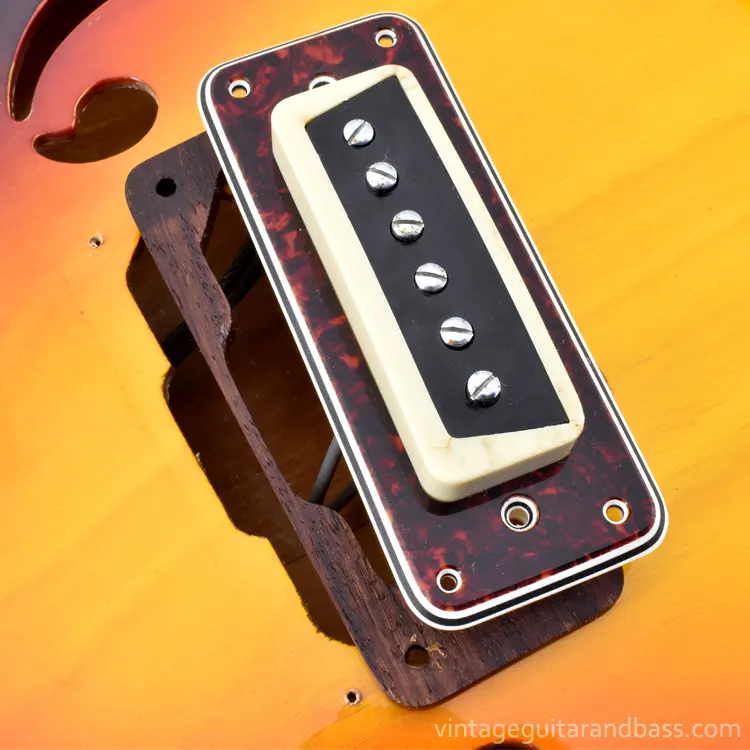
Angelica twelve string. The bridge pickup of hollow bodies is typically raised with a rosewood spacer. Note that the pickups are identical for both 6 and 12 string guitars.

Angelica twelve string neck pickup, with red tortoiseshell surround. The two pickup height adjustment bolts are 1" oval cross head pre-1967 JIS M3 bolts (3mm 0.60 pitch). The four mounting screws are 10mm oval crosshead. Note, both the surrounds in this image, and the image below are original and from the same guitar. It is not unusual to see these in any shade from original white to aged cream.

Angelica twelve string bridge pickup, with red tortoiseshell surround and rosewood spacer. The two pickup height adjustment bolts are 1" oval cross head pre-1967 JIS M3 bolts (3mm 0.60 pitch). The four mounting screws are 17mm (5/8") oval crosshead.

Side view of mounted pickup, showing mounting bolts and springs.

Matsumoku trapezoid pickups mounted to a 1971 Epiphone 1802T (ET-270) pickguard.

Underside view of unmounted pickups.
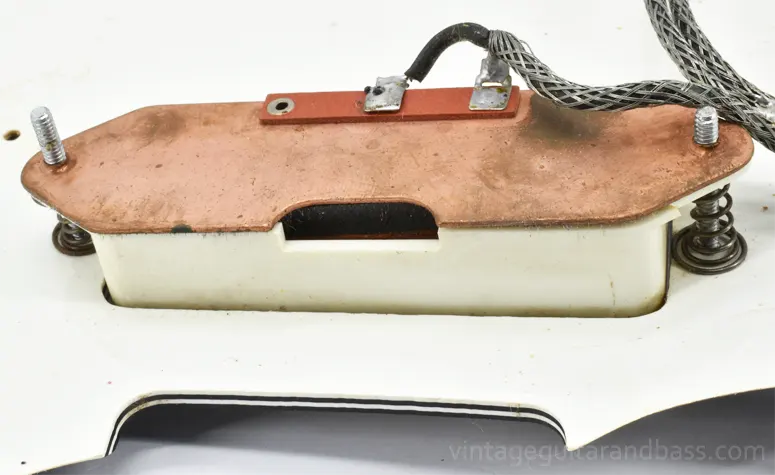
The pickup underside (pickguard mounted) from a 1971 Epiphone 1802T.
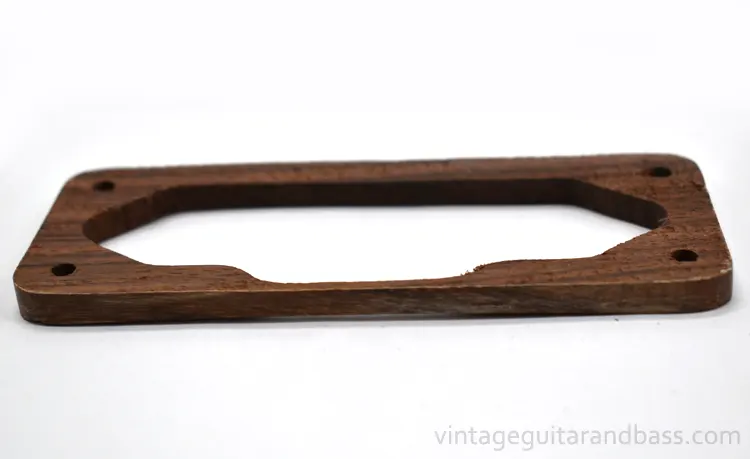
The spacer underside is curved to fit against the arched top of the guitar. Dimensions: height 4.6mm in center up to 6.0mm at edges. Cutout 98.3mm x 28.5mm (34.6mm at widest point).

Cream plastic cover and black top insert

Cream plastic cover and black top insert (underside). The cover has dimensions 74.6mm (97.2mm with tabs) x 26.7mm x 24.0mm tall. The black top-piece has dimensions 71.1mm x 20.9mm x 4.6mm (max).
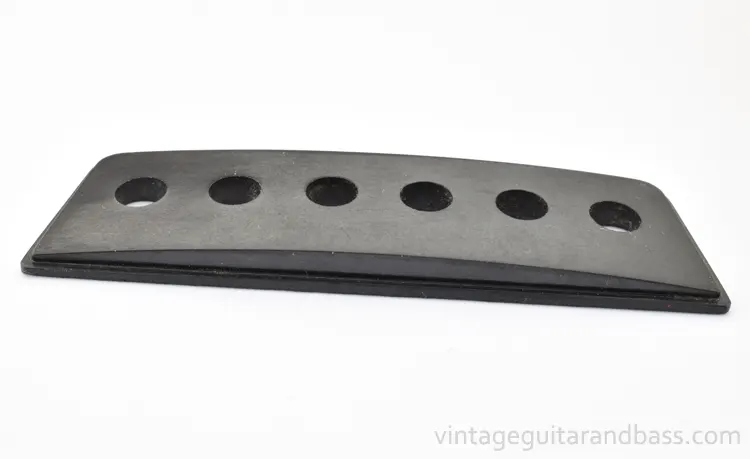
Black top insert detail.
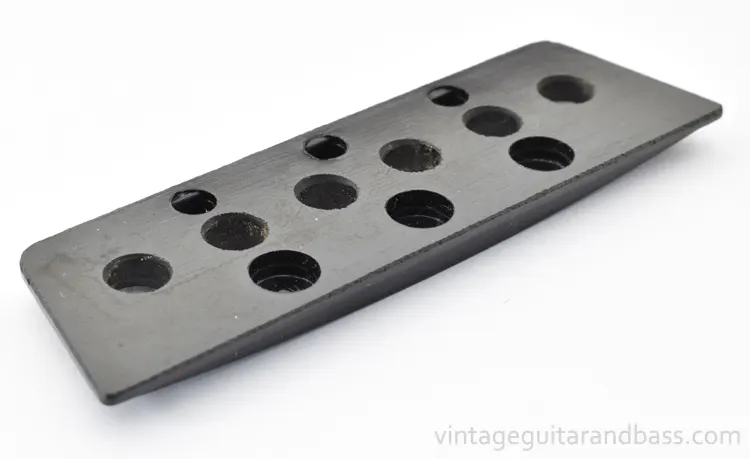
Black top insert detail, underside.
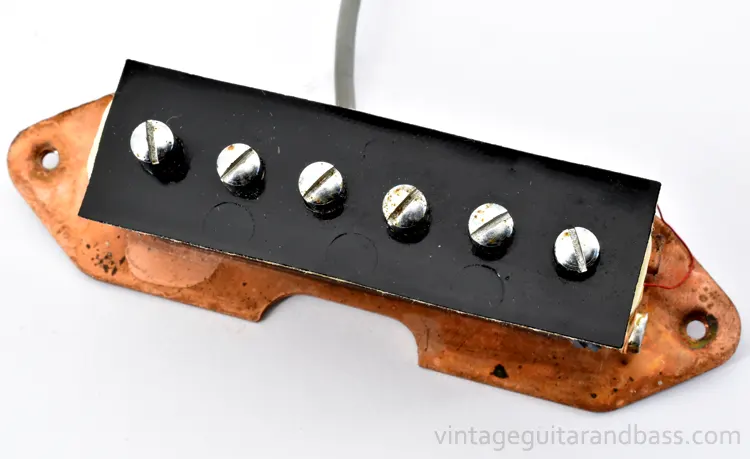
Matsumoku trapezoid pickup with cover removed. A black 'fabric' vinyl rectangle (20mm x 66mm) sits directly above the coil. Identical vinyl strips also appear inside the Maxon humbuckers fitted to other Matsumoku guitars - a possible clue as to the origin of this pickup.

Vinyl removed to show coil former. The windings are covered by cream tape.

This example (from a 1971 Epiphone 1802T) merely has smaller vinyl fabric pieces at each end of the pickup.
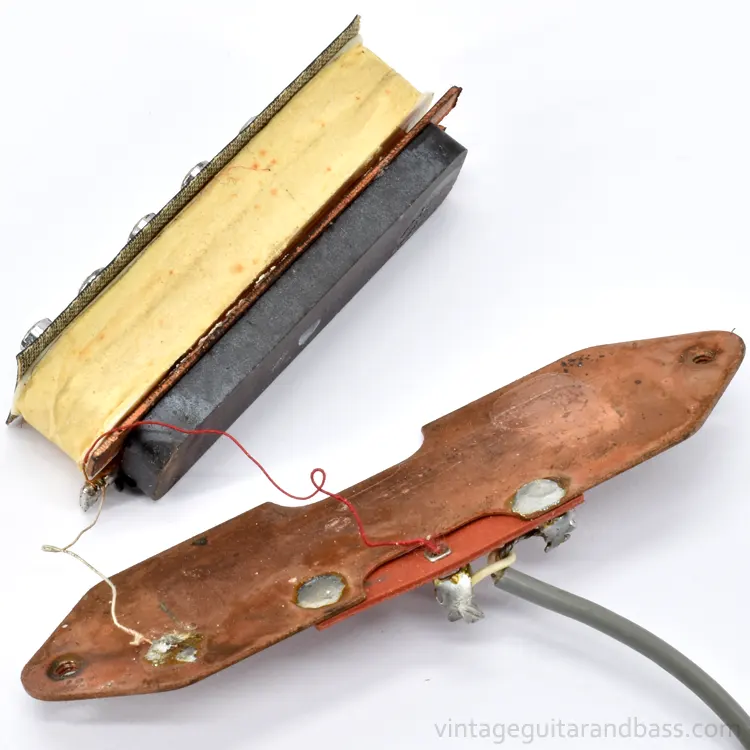
The white plastic loom sits above a copper-coloured frame, which is in turn glued to the magnet. The magnet sits (and is held in place magnetically) on a copper-coloured baseplate. Light glue residue suggests this may once have been lightly glued in place. These 'copper' parts are ferromagnetic, no doubt some kind of alloy.
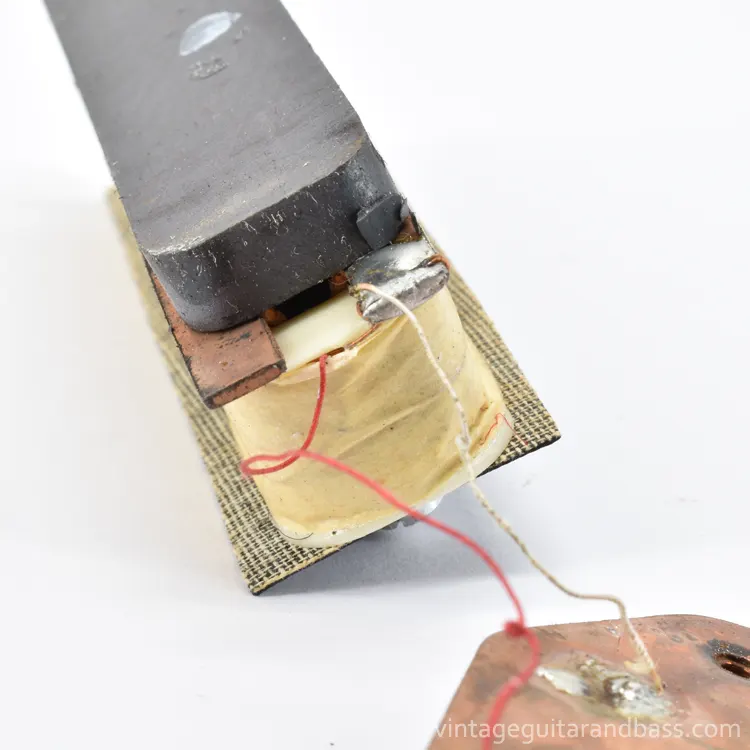
This end-on view shows the wires leaving the coil: the white attached to the baseplate, the red connecting to the guitar's controls, via the terminal riveted to the underside of the baseplate.
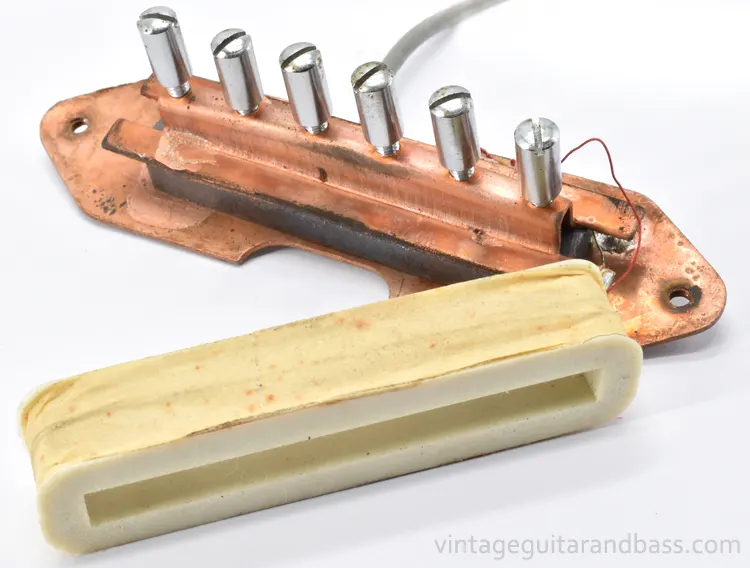
With the loom / former removed the polepiece frame is visible. It consists of a folded metal sheet, with threaded holes holding the polepieces.
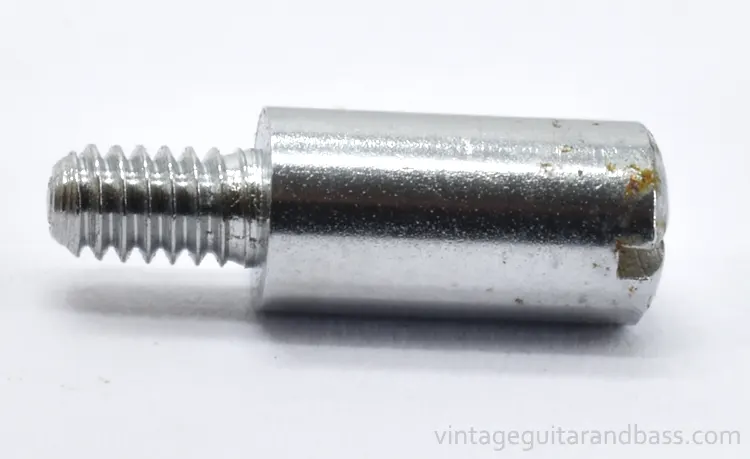
The polepieces simply unscrew from the frame beneath the former. Polepiece dimensions: 5mm diameter, 15.1mm long, 5.0mm of which is threaded (pre-1967 JIS M3, with 0.6mm pitch). Very similar design pole pieces appear inside the Maxon humbuckers fitted to other Matsumoku guitars - another suggestion as to the origin of this pickup.


Matsumoku trapezoid pickup coil, magnet and baseplate and frame, with polepieces removed.
$45
$95
$49
$40
$50
$85
$125
$135
$90
$30
$115
$85
$119
$125
$95
$60
$55
$50
$395
$65